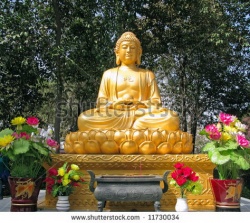Pure Land School (Jingtuzong 淨土宗)
The Pure Land School (Jingtuzong 淨土宗, Jap. Jōdo shū, Kor. Chŏngt'o jong) that focuses on the simple Amitābha (Chin. Namo Amituofo 南無阿彌陀佛; Jap. Amida, Kor. Amit'a) cult, was already founded by Huiyuan 慧遠 during Eastern Jin, but the monk Shandao 善導 (d. 681) was its forming patriarch. Its basic writings are the (Fo shuo) Wuliangshou jing (佛說)無量壽經 "Sutra on Infinite Lifespan (as preached by the Buddha)" (T 360) and (Fo shuo) Amituo jing (佛說)阿彌陀經 "Amitabha Sutra" (T 366; both usually called the Larger and Smaller Amitabha Sutra), and the (Fo shuo) Guan wuliangshou Fo jing "Sutra on Contemplating the Buddha of Infinite Lifespan" (Contemplation Sutra, T 365). Both decribe the Western Paradise, the access to which is possible by meritorious deeds as well as faith and devotion to the Amitabha Buddha. A central deity in Jingtu Buddhism is the Guanyin (jap.: Kan'on) Bodhisattva, the Chinese form of the Avalokiteshvara. Shandao wrote that five activities could lead to rebirth in the Western Paradise: uttering the name of the Buddha (nian Fo 念佛), chanting the sutras, meditating on the Buddha, worshipping and singing praises to the Buddha. The Pure Land School is one of the most popular of Buddhist schools and has still many believers today.
